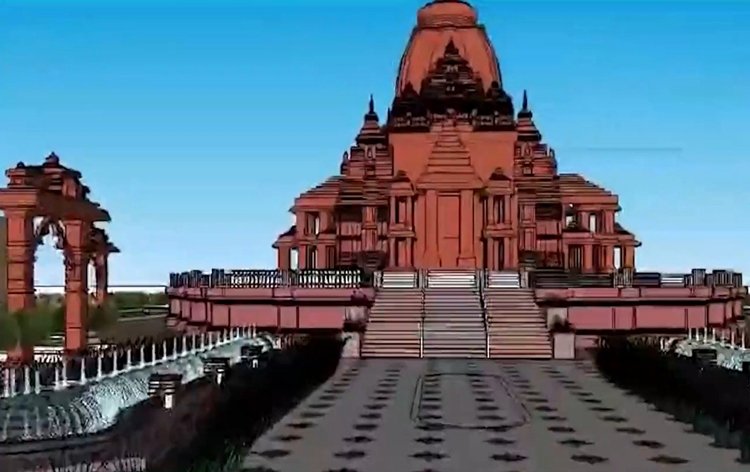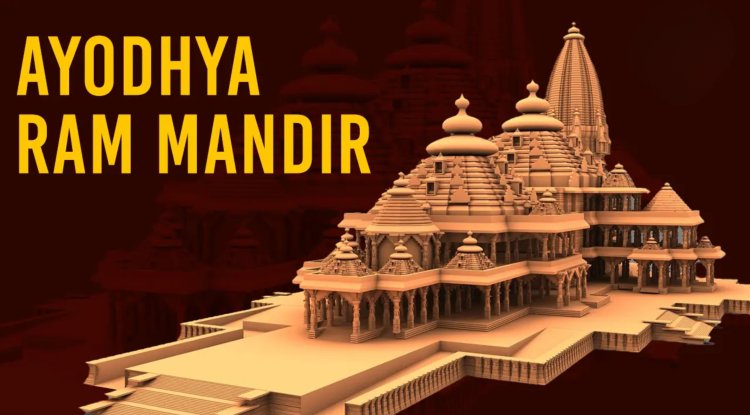Kalki Dham: Unveiling the Mystery of the Temple for the Tenth Avatar of Lord Vishnu
Amidst the fertile plains of Uttar Pradesh, India, where ancient history and religious fervor intertwine, a new chapter is set to unfold. The foundation of Kalki Dham, a temple dedicated to the prophesied tenth avatar of Lord Vishnu, Kalki, was laid on February 19, 2024, by Prime Minister Narendra Modi. This ambitious project, shrouded in both spiritual intrigue and socio-political undercurrents, is poised to become a landmark, igniting the imaginations of devotees and sparking critical discourse.

Unveiling the Mythos: Kalki, the Resurrector
In Hindu mythology, Kalki signifies the tenth and final avatar of the divine preserver, Lord Vishnu. He is prophesied to arrive on a white horse at the end of Kali Yuga, the current age of darkness and strife, to vanquish evil and usher in a new era of Sat Yuga, a golden age of righteousness and peace.
The scriptures provide vivid descriptions of Kalki's appearance: riding a white horse, wielding a flaming sword, and possessing immense wisdom and strength. He is depicted as a warrior-king, restoring dharma and eradicating adharma, establishing justice and harmony.
While the exact timing of Kalki's arrival remains veiled in mystery, the concept sparks profound questions about faith, the cyclical nature of time, and the hope for a better future. For many devotees, Kalki Dham symbolizes not just a temple, but a beacon of hope for a renewed world cleansed of suffering.
The Architectural Vision: A Monument to the Tenth Avatar of Lord Vishnu
The Kalki Dham project envisions a sprawling 5-acre complex, blending traditional Hindu architecture with modern design elements. Its centerpiece will be a grand temple, soaring with a 108-foot shikhara (spire) and adorned with intricate carvings depicting scenes from various scriptures. Ten distinct garbhagrihas (sanctums) will house idols of Lord Vishnu's ten avatars, with the central one reserved for Kalki.
The design incorporates unique features, emphasizing sustainability and inclusivity. The use of pink sandstone, reminiscent of the Ayodhya Ram Mandir, is a symbolic gesture. Additionally, the avoidance of steel and iron aligns with traditional temple architecture and echoes environmental consciousness.
Beyond the temple, the complex will encompass meditation halls, educational facilities, gardens, and cultural spaces. This holistic approach aims to create a pilgrimage destination that caters not only to spiritual needs but also fosters intellectual and social engagement.
Socio-Political Implications: Faith and the Public Sphere
The construction of Kalki Dham has elicited diverse reactions. While some hail it as a testament to India's rich cultural heritage and a potential catalyst for spiritual awakening, others raise concerns about the blurring lines between religion and politics.
The involvement of Prime Minister Modi in the foundation stone laying ceremony has ignited discussions about the potential political implications. Some suggest it could be a strategic move to garner support in crucial electoral regions, while others view it as a genuine expression of personal faith.
Furthermore, the temple's proximity to upcoming 2024 elections adds another layer of complexity. Balancing religious freedom with secular principles remains a crucial challenge for India's diverse tapestry.
Beyond the Controversy: Unifying Hopes and Questions
The Kalki Dham project, undoubtedly, will generate debate and intrigue for years to come. Regardless of individual interpretations, it presents a unique opportunity to explore the confluence of faith, architecture, and socio-political dynamics.
Whether interpreted as a symbol of religious devotion, a catalyst for social change, or a political maneuver, Kalki Dham stands as a testament to the enduring power of human aspirations for a better world. Beyond the controversies, it holds the potential to unite communities in shared curiosity, engaging discussions, and the quest for a brighter future.
A Historical Lens on Kalki Dham: Temple Building, Vishnu's Avatars, and the Evolving Kalki Concept
The foundation of Kalki Dham, dedicated to the prophesied tenth avatar of Lord Vishnu, resonates deeply within a rich historical context of temple construction in India, particularly those honoring Vishnu's various incarnations. Examining this history, along with the evolving interpretations of Kalki in Hindu scriptures and the figures who emphasized his arrival, offers a more nuanced understanding of this ambitious project.
Temples of Vishnu's Avatars:
Throughout India's history, grand temples have been erected to celebrate Lord Vishnu's diverse avatars. These architectural marvels not only serve as devotional spaces but also embody cultural expressions and historical narratives.
- Vaikuntha Perumal Temple (Kanchipuram): Dedicated to Vishnu's celestial abode, this 8th-century temple showcases Dravidian architecture and intricate sculptures depicting different avatars.
- Jagannath Temple (Puri): This iconic 12th-century temple enshrines Jagannath, a regional form of Vishnu associated with Krishna. Its annual Rath Yatra procession is a renowned cultural spectacle.
- Tirupati Tirumala Venkateswara Temple (Andhra Pradesh): One of the most visited pilgrimage sites in India, this temple venerates Venkateswara, believed to be a form of Vishnu associated with prosperity and liberation.
These, and countless other examples, demonstrate the deep-rooted tradition of building temples for specific avatars, highlighting their unique attributes and significance within the wider Vishnu narrative.
The Evolution of Kalki in Scriptures:
While the core concept of Kalki as the final avatar restoring dharma appears across various Hindu texts, his portrayal and characteristics evolve over time.
- Early Puranas: The Vishnu Purana and Bhagavad Gita mention Kalki briefly, portraying him as a righteous warrior ushering in a new age.
- Kalki Purana: This later text, composed around the 10th-12th centuries, elaborates on Kalki's life, lineage, and battles, offering a more detailed vision of his arrival.
- Regional interpretations: Folk traditions and regional narratives across India often present unique interpretations of Kalki, associating him with local deities and cultural heroes.
This evolution reflects the dynamic nature of Hindu scriptures and the continuous reinterpretation of divine figures based on historical contexts and social needs.
Figures and Movements Emphasizing Kalki:
Throughout history, several figures and movements have emphasized the idea of Kalki's arrival:
- Bhakti saints: Mystics like Ramanuja and Chaitanya Mahaprabhu interpreted Kalki as a symbol of divine grace and spiritual renewal.
- Reform movements: During colonial rule, figures like Swami Vivekananda saw Kalki as a symbol of national regeneration and spiritual revival.
- Messianic interpretations: In times of societal upheaval and injustice, some interpret Kalki as a literal figure leading a righteous uprising.
These diverse movements highlight the multifaceted understanding of Kalki, ranging from spiritual hope to social and political aspirations.
Kalki Dham: A Catalyst for Cultural Identity, Tourism, and Tradition?
The construction of Kalki Dham holds the potential to significantly impact the region's cultural landscape, attracting pilgrims, strengthening local identity, and fostering artistic expression. Let's delve into these possibilities:
Strengthening Regional Identity:
- Symbol of Heritage: Kalki Dham can become a potent symbol of the region's rich Hindu heritage, attracting devotees and fostering a sense of shared identity. This can be further enhanced by incorporating local architectural styles, materials, and craftsmanship into the temple design.
- Cultural Hub: The complex can evolve into a vibrant hub for cultural activities, hosting educational programs, workshops on traditional arts, and showcasing regional literature and music. This can foster a sense of cultural pride and promote intergenerational transmission of traditions.
- Economic Boost: The increased tourism and pilgrimage footfall can create employment opportunities and revive local businesses, further strengthening the regional economy and cultural self-sufficiency.
Attracting Pilgrimage Tourism:
- Pilgrimage Destination: Kalki Dham, with its unique focus on the prophesied avatar, has the potential to attract devotees not only from India but also from across the globe. This can lead to increased tourism revenue, benefiting local communities and businesses.
- Spiritual Tourism: The temple complex can offer various spiritual experiences, such as meditation halls, yoga classes, and guided tours, catering to a growing segment of spiritual tourists seeking inner peace and cultural immersion.
- Sustainable Tourism: Implementing sustainable practices like eco-friendly construction, waste management, and responsible resource utilization can attract environmentally conscious tourists and contribute to the region's long-term well-being.
Integrating Local Art, Music, and Dance:
- Temple Architecture: Integrating regional architectural styles, motifs, and sculptures into the temple design can create a visually stunning and culturally resonant space. Utilizing local artisans and materials can further enhance the project's authenticity.
- Performance Arts: Regularly hosting traditional music and dance performances within the complex can showcase the region's vibrant cultural heritage and create a unique atmosphere for devotees and visitors.
- Festivals and Celebrations: Integrating local festivals and celebrations into the temple calendar can create a sense of community engagement and attract wider participation. This can also promote cultural exchange and understanding.
Impact on Cultural Festivals and Religious Practices:
- Revival of Traditions: Kalki Dham can act as a catalyst for the revival of local religious practices and festivals that might have faded over time. The temple can provide a platform for showcasing these traditions to a wider audience, ensuring their continued relevance.
- Evolution of Practices: The presence of a major temple can sometimes lead to the evolution of existing religious practices. This can be positive, encouraging inclusivity and accessibility, but it's crucial to ensure respect for traditional customs and maintain a balance.
- Interfaith Dialogue: The temple can serve as a platform for interfaith dialogue and understanding, fostering respect and collaboration between different communities. This can be particularly important in a diverse region like India.
Kalki Dham: Economic Engine or Ethical Enigma?
The construction of Kalki Dham promises significant economic benefits to the region, but with them come potential challenges and ethical considerations. Let's explore this complex relationship:
Economic Benefits:
- Job Creation: The project itself requires a vast workforce for construction, skilled artisans, and hospitality personnel. This injects capital into the local economy, boosting employment and improving livelihoods.
- Infrastructure Development: Building the temple complex necessitates improvements in roads, transportation, communication networks, and utilities. This infrastructure upgrade benefits not only the temple but also the surrounding communities.
- Tourism Revenue: Increased pilgrimage and tourist footfall translates to higher revenue for hotels, restaurants, transportation providers, and souvenir shops. This can revitalize local businesses and create new entrepreneurial opportunities.
- Investment and Development: The project can attract further investments in the region, leading to the development of hotels, cultural centers, and other amenities, boosting the long-term economic trajectory.
Challenges and Responsible Management:
- Fair Wages and Working Conditions: Ensuring fair wages, safe working conditions, and adherence to labor laws is paramount to prevent exploitation of workers, particularly migrant laborers.
- Sustainable Tourism: Managing increased tourism responsibly requires proper waste management, sustainable resource utilization, and infrastructure upgrades to avoid environmental degradation and cultural burden.
- Community Engagement: Local communities should be actively involved in decision-making processes to ensure equitable distribution of benefits and prevent displacement due to development projects.
- Long-Term Planning: Sustainable economic growth demands long-term planning to manage waste, resource depletion, and potential future infrastructure needs.
Ethical Considerations:
- Commercialization and Exploitation: Striking a balance between religious sentiment and commercial exploitation is crucial. Aggressive marketing, excessive commercialization within the temple complex, and profiteering can dilute the spiritual essence and exploit devotees' fervor.
- Inclusive Development: Project benefits should reach all sections of the community, avoiding exclusion or marginalization of vulnerable groups. Ensuring inclusive economic participation and addressing potential inequalities remains an ethical imperative.
- Transparency and Accountability: Transparent financial management, responsible use of funds, and clear accountability mechanisms are essential to maintain public trust and prevent corruption or misuse of resources.
While Kalki Dham offers promising economic opportunities, responsible management, community engagement, and ethical considerations are critical to harnessing its full potential. Balancing the need for development with sustainability, inclusivity, and respect for religious values will determine the project's long-term success and its positive impact on the region's economic and social well-being.
Kalki Dham in Global Context: Messianic Hopes and Interfaith Bridges
Kalki Dham, dedicated to the prophesied tenth avatar of Vishnu, stands among other ambitious religious projects worldwide centered on messianic figures and prophecies. Examining its similarities and differences, and exploring its potential global appeal and interfaith significance, offers a broader perspective on this unique initiative.
Comparing Kalki Dham:
- Similarities:
- Messianic Hope: Like projects dedicated to the second coming of Christ (e.g., Sagrada Familia), Maitreya Buddha (e.g., Maitreya Project in Thailand), or Imam Mahdi (e.g., Jamkaran Mosque in Iran), Kalki Dham embodies hope for a future of redemption and renewal led by a divine figure.
- Cultural Significance: Similar to Shwedagon Pagoda in Myanmar or Mecca in Saudi Arabia, Kalki Dham aims to be a pilgrimage destination, attracting devotees and strengthening cultural identity.
- Architectural Grandeur: Like Sagrada Familia's intricate design or the Taj Mahal's intricate details, Kalki Dham's planned architecture signifies grandiosity and spiritual devotion.
- Differences:
- Religious Context: Kalki Dham arises within Hinduism, emphasizing a specific avatar within its complex pantheon. Projects like the Sagrada Familia represent Christianity, while others reflect distinct theological frameworks.
- Scale and Focus: While some projects are global movements (e.g., Maitreya Project), Kalki Dham currently focuses on regional Indian appeal. Its scope might evolve in the future.
- Interpretation and Controversies: The Kalki concept's specific interpretations within Hinduism can vary, leading to potential controversies. Other projects might have more unified theological interpretations.
Global Appeal of Kalki:
- Hope for Renewal: The concept of a messianic figure arriving to restore dharma resonates with universal human desires for justice, peace, and a better future, potentially appealing to individuals beyond Hinduism.
- Cultural Exchange: Kalki Dham can offer a window into Hindu beliefs and cultural expressions, fostering understanding and appreciation across different cultures and faiths.
- Interfaith Dialogue: Exploring the Kalki concept in a global context can spark productive interfaith dialogue on shared messianic hopes, fostering respect and collaboration towards a better future.
Interfaith Cooperation:
- Shared Values: Despite theological differences, projects like Kalki Dham and others share common values like compassion, justice, and peace, providing a foundation for interfaith cooperation.
- Addressing Global Challenges: Collaboration on issues like poverty, climate change, and conflict resolution can be inspired by shared messianic hopes for a better world.
- Promoting Understanding: Open dialogue and collaboration between faith communities can combat prejudice, foster empathy, and build bridges of understanding.
Kalki Dham, within its regional context, shares similarities and differences with other messianic projects globally. Its potential appeal lies in its message of hope and renewal, which resonates with broader human aspirations. By fostering interfaith dialogue and cooperation, such projects can contribute to a more peaceful and just world, guided by shared hopes for a brighter future.
Voices of Kalki Dham: Personal Journeys and Transformations
Stepping beyond statistics and analyses, the human element lies at the heart of Kalki Dham. To truly understand its impact, we must hear the diverse voices woven into this ambitious project. Let's explore the motivations, experiences, and transformations of individuals involved:
Vishwakarma, Stone Carver: "For me, sculpting the temple walls is an act of devotion. Each stroke embodies my hopes for a future guided by Kalki's justice and harmony. It's more than a job; it's a prayer in stone."
Dr. Meenakshi Sharma, Architect: "Designing Kalki Dham is an opportunity to blend tradition with innovation. We aim to create a space that embodies spiritual grandeur while respecting ecological sustainability. It's a challenge, but one that inspires me deeply."
Ramesh Prasad, Devotee: "Ever since I heard about Kalki Dham, a sense of hope has blossomed within me. I believe Kalki's arrival signifies a brighter future for our world. Visiting the construction site fills me with immense joy and anticipation."
Radha Kumari, Volunteer: "Helping build the temple isn't just about serving my faith; it's about being part of a community united by shared aspirations. Working alongside others, I feel a sense of purpose and belonging I haven't experienced before."
Swami Ananda Giri, Spiritual Leader: "Kalki Dham is more than just a temple; it's a symbol of spiritual awakening. Engaging with Kalki's message can inspire individuals to lead more righteous lives, fostering positive change within themselves and communities."
Aisha Khan, Local Resident: "While I don't share the same faith, I see Kalki Dham as an opportunity for our region. It brings tourism, jobs, and hope for development. I look forward to experiencing the cultural richness it will bring."
These diverse voices showcase the multifaceted impact of Kalki Dham. From artisans finding purpose in their craft to devotees experiencing renewed hope, and architects striving for innovation, the project touches lives in numerous ways.
Transformative Impact of Faith:
Engagement with Kalki Dham can potentially lead to individual transformations:
- Strengthened values: Devotees might strive to embody Kalki's virtues of justice, compassion, and righteousness in their daily lives.
- Sense of purpose: Contributing to the project, volunteering, or simply connecting with the message can inspire a sense of purpose and belonging.
- Community building: Collaborating on a shared endeavor fosters social connections and strengthens community bonds.
- Inner peace: Reflecting on Kalki's message and participating in spiritual practices can lead to inner peace and self-reflection.
While these are potential outcomes, individual experiences will vary. Importantly, respecting diverse perspectives and fostering interfaith dialogue remain crucial for building a truly inclusive and harmonious future.
Conclusion: A Legacy in Stone and Spirit
Kalki Dham stands as a testament to the enduring power of faith, hope, and the human desire for a better future. While its impact on the regional economy, cultural landscape, and individual lives remains to be seen, the project undoubtedly sparks curiosity and dialogue. Whether viewed as a religious monument, a cultural landmark, or a catalyst for social change, Kalki Dham offers a unique lens into the intricate interplay of faith, tradition, and progress in contemporary India.
What's Your Reaction?


















